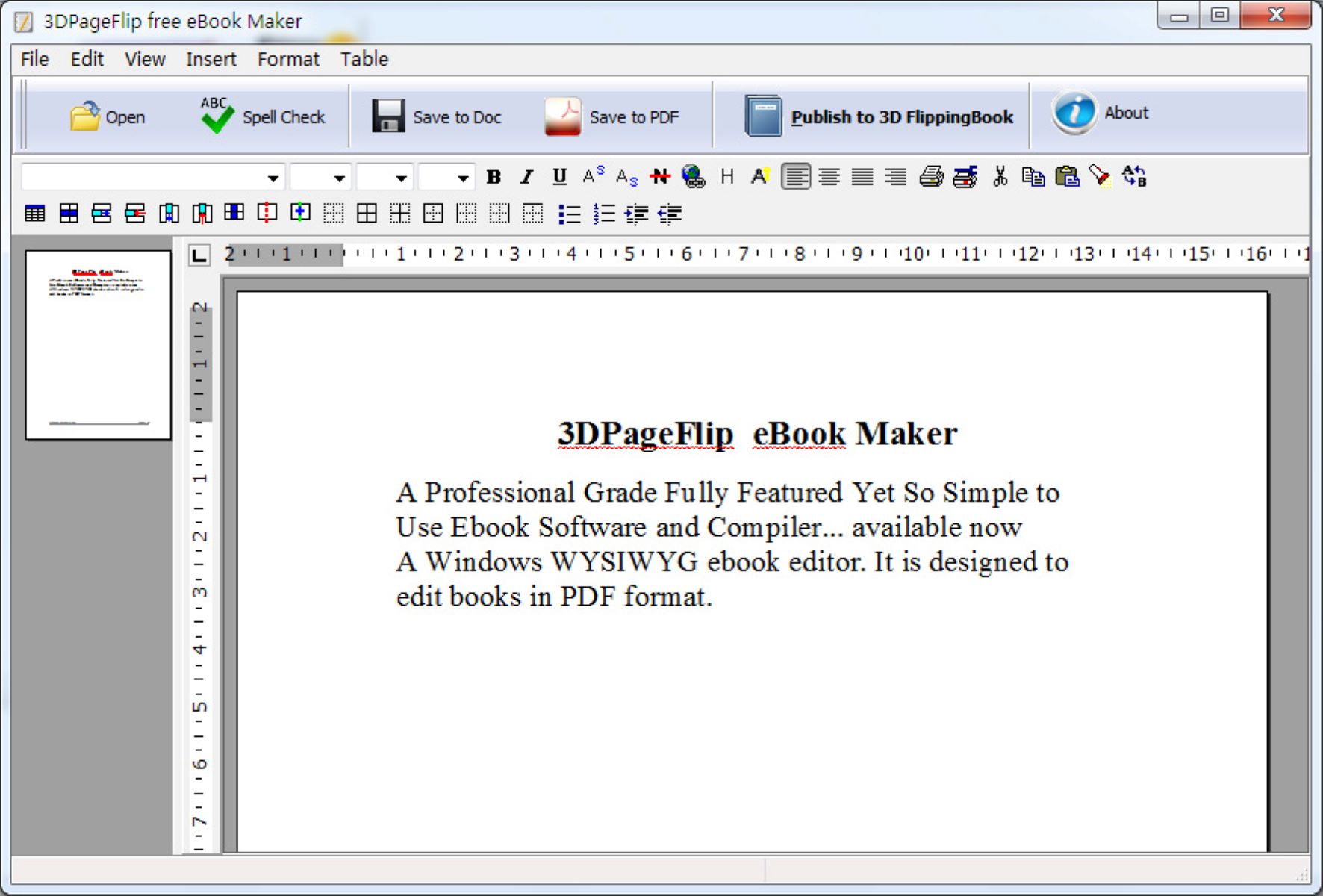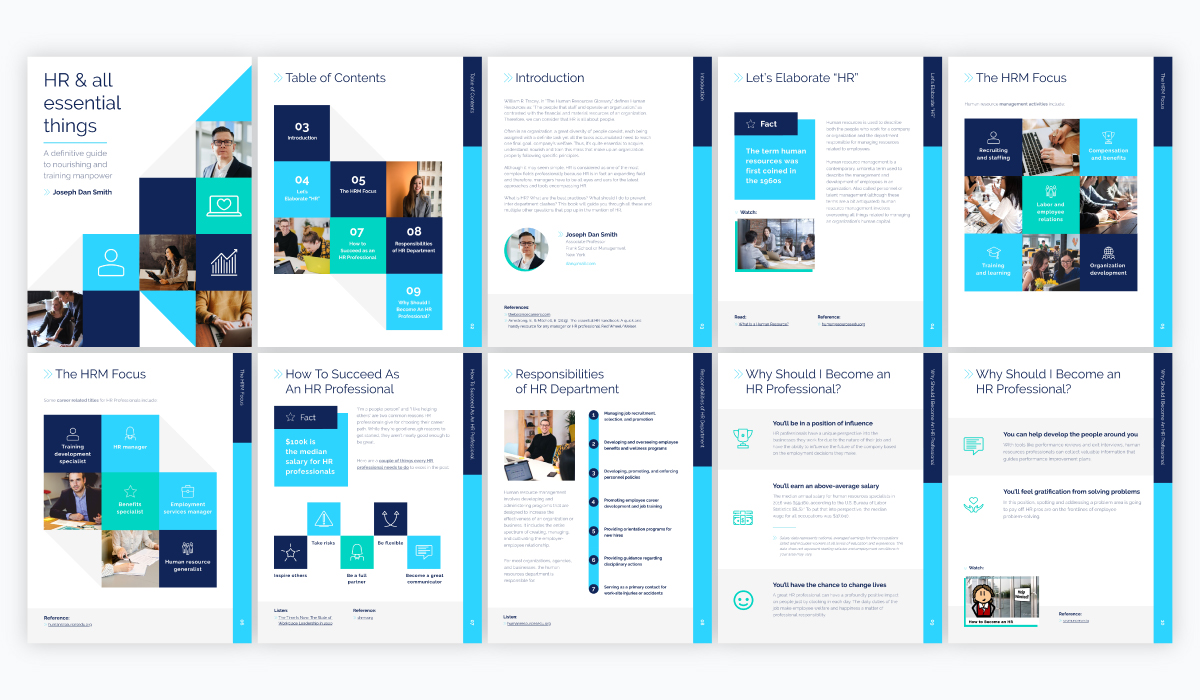Introduction
Welcome to the world of eBook creation! Gone are the days when publishing a book was limited to traditional methods. With the advent of technology, anyone can now transform their thoughts and ideas into a beautifully designed eBook. And one of the most accessible and user-friendly tools for creating an eBook is Google Docs.
In this guide, we will walk you through the step-by-step process of creating an eBook using Google Docs. Whether you’re a budding author, a business professional, or a passionate blogger, this tutorial will equip you with the knowledge and techniques to bring your eBook to life.
Google Docs is a versatile online word processing tool that offers a wide range of formatting options, collaborative features, and accessibility across devices. It allows you to write, edit, and format your eBook seamlessly, making it an ideal choice for both beginners and experienced writers.
Throughout this guide, we will cover various aspects of eBook creation, from setting up your document to adding images, creating a table of contents, and adding hyperlinks. We’ll also delve into the crucial steps of proofreading and editing, as well as sharing and publishing your eBook.
By the end of this tutorial, you’ll have a comprehensive understanding of how to create an eBook in Google Docs, enabling you to share your knowledge, stories, or expertise with a wider audience.
So, let’s dive in and start your journey towards becoming an eBook author!
Step 1: Setting up your document in Google Docs
The first step in creating your eBook is to set up your document in Google Docs. Follow these steps to get started:
- Create a new document: Open Google Docs and click on the blank document option to start a new project. This will open a fresh document where you can begin crafting your eBook.
- Title your eBook: Give your eBook a catchy and descriptive title. This will appear at the top of each page and help readers easily identify your work. Consider using a larger font size or applying a heading style to make it stand out.
- Choose the fonts and formatting: Select the fonts and formatting options that align with the style and tone of your eBook. Google Docs offers a wide range of font choices, including professional-looking serif fonts and modern sans-serif fonts. Ensure that your font size is comfortable to read and that the line spacing is appropriate.
- Set the margins and page size: Adjust the margins and page size according to your preference. For eBooks, it is common to use the standard 8.5 x 11 inch page size or opt for a more eBook-friendly size like 6 x 9 inches. This will ensure that your content fits well on various e-reader devices.
- Enable page numbering: In the header or footer section, click on the “Insert” tab and select “Page numbers.” Choose the desired location for your page numbers, such as top-right or bottom-center. This will help readers navigate through your eBook easily.
- Create headers and subheaders: To organize your eBook and make it reader-friendly, create headers and subheaders for different sections or chapters. Use the built-in styles in Google Docs, such as “Heading 1” for main headers and “Heading 2” for subheaders. This will create a consistent structure throughout your eBook.
- Add a footer: Consider adding a footer with useful information like your name, copyright details, or a link to your website or social media profiles. This can be done by going to the “Insert” tab and selecting “Footer.” Customize the footer content to match your eBook’s branding and purpose.
Remember, the setup phase lays the foundation for your eBook, so take your time to ensure that everything is set up correctly. Once you have completed these initial steps, you can move on to the exciting task of formatting your eBook and making it visually appealing. So, let’s jump into the next step!
Step 2: Formatting your eBook
Now that you have set up your document in Google Docs, it’s time to focus on formatting your eBook to make it visually appealing and easy to read. Follow these guidelines to format your eBook effectively:
- Select a consistent font style: Choose a font style that is easy to read and visually pleasing. Stick to a single font throughout your eBook to maintain consistency. Popular eBook fonts include Arial, Times New Roman, and Calibri.
- Apply appropriate font sizes: Use a font size that ensures readability. Larger fonts, such as 12 or 14 points, are considered standard for eBook content. Adjust the font size for headings to make them stand out without overpowering the body text.
- Use proper paragraph spacing: Ensure that there is enough spacing between paragraphs to make your eBook visually appealing. A spacing of 1.5 or double spacing is commonly used to improve readability. Avoid excessive spacing, as it may make your eBook appear too long.
- Utilize headings and subheadings: Break down your eBook into sections and chapters by using headings and subheadings. This hierarchical structure helps readers navigate your eBook and find specific information easily. Format the headings using larger fonts or bold styling.
- Add emphasis with italics and bold: Use italics or bold formatting to emphasize important words or phrases in your eBook. However, use them sparingly to avoid distracting readers. Reserve these formatting styles for key points, definitions, or quotes.
- Include bullet points and numbered lists: When presenting lists or steps, utilize bullet points or numbered lists. This formatting style makes it easier for readers to grasp information and follow instructions. Bullet points are suitable for unordered lists, while numbered lists are ideal for sequential steps or rankings.
- Consider using block quotes: If you want to highlight a significant quote or extract from another source, use block quotes. This formatting style visually sets the quote apart from the main text, adding emphasis and drawing attention to the important message.
- Keep paragraphs concise: Write short and concise paragraphs to maintain the reader’s interest. Long paragraphs can appear daunting and make it difficult for readers to scan or skim through your eBook. Break large chunks of text into smaller, more digestible paragraphs.
Remember, formatting plays a crucial role in enhancing the reading experience of your eBook. By applying consistent styles and structuring your content effectively, you’ll create a visually appealing eBook that engages your readers. With the formatting completed, it’s time to move on to the next step: adding images, charts, and graphs to enrich your eBook. Let’s explore!
Step 3: Adding images, charts, and graphs
Visual elements such as images, charts, and graphs can greatly enhance the overall quality and engagement of your eBook. By incorporating these visuals, you can effectively convey information, break up text-heavy sections, and make your eBook visually appealing. Here are some guidelines for adding images, charts, and graphs to your eBook using Google Docs:
- Choose high-quality images: When selecting images for your eBook, ensure they are high-resolution and relevant to the content. You can use royalty-free image websites or create custom visuals to add a personal touch. Avoid blurry or pixelated images, as they can detract from the overall quality of your eBook.
- Insert images into your document: To insert an image, click on the “Insert” tab in Google Docs and select “Image.” Choose an image from your computer or search online to find the desired visuals. You can then adjust the size, position, and alignment of the image within your eBook.
- Create charts and graphs: To present data or statistics in a visually appealing manner, utilize Google Docs’ built-in chart and graph creation tools. Click on the “Insert” tab, select “Chart,” and choose the appropriate chart or graph type for your data. Customize it with labels, titles, and colors to match your eBook’s style.
- Provide captions for visuals: To provide context and enhance the reader’s understanding, add captions to your images, charts, or graphs. Captions can be inserted below or beside the visuals, using a slightly smaller font size. Ensure that the captions are concise and relevant.
- Consider formatting options: Experiment with different formatting options to make your visuals stand out. Apply borders, shadows, or different colors to create a professional and visually appealing look. However, be mindful not to overcrowd the visuals with too many formatting elements.
- Ensure proper placement: Place the visuals strategically within your eBook, aligning them with relevant text or sections. This helps readers easily associate the visuals with the corresponding content and improves the flow of your eBook.
- Provide alt text: Alt text is an essential accessibility feature that describes the content of images for visually impaired readers. Include alt text for each image, providing a concise and accurate description. This ensures that your eBook is accessible to a wider audience.
Remember, visuals can effectively convey information and enhance the reader’s experience, so use them wisely. However, be selective and ensure that they add value to your eBook rather than overwhelming or distracting readers. With your visuals in place, you’re one step closer to creating a comprehensive and engaging eBook. In the next step, we’ll explore how to create a table of contents for easy navigation. Let’s dive in!
Step 5: Adding hyperlinks
Hyperlinks are a valuable tool for enhancing interactivity and providing additional resources within your eBook. By incorporating hyperlinks, you can direct readers to external websites, relevant articles, or even other sections within your eBook. Here’s how you can add hyperlinks to your eBook in Google Docs:
- Select the target text or image: Identify the text or image in your eBook that you want to turn into a hyperlink. This could be a keyword, phrase, or visual element that you want readers to click on.
- Insert the hyperlink: With the target text or image selected, click on the “Insert” tab in Google Docs and choose “Link.” A dialogue box will appear, allowing you to enter the URL or web address you want the hyperlink to point to.
- Customize the hyperlink: Optionally, you can modify the appearance of the hyperlink. Google Docs provides options to change the font color, underline style, and formatting of the hyperlink. Choose a style that fits your eBook’s design and makes the hyperlink stand out.
- Add internal links: If you want to direct readers to a specific section within your eBook, you can create internal links. Select the text or image that will serve as the link anchor, then right-click and choose “Link.” In the dialogue box, select “Headings” and choose the section you want to link to. This allows readers to easily navigate through your eBook.
- Test the hyperlinks: Once you have added the hyperlinks, it’s important to test them to ensure they work correctly. Click on each hyperlink and verify that it successfully opens the intended webpage or jumps to the specified section within your eBook.
- Provide descriptive anchor text: To make your hyperlinks more informative and meaningful, use descriptive anchor text instead of generic phrases like “click here” or “learn more.” This helps readers understand the purpose of the link before clicking on it.
- Use hyperlinks judiciously: While hyperlinks are useful, it’s important not to overuse them. Use hyperlinks only when they add value and provide relevant information or resources. Too many hyperlinks can cause distraction and interrupt the reading flow of your eBook.
By incorporating hyperlinks strategically, you can provide additional context, resources, and opportunities for readers to explore further. It adds interactivity to your eBook and enhances the overall reading experience. With hyperlinks now in place, it’s time to move on to the next step: proofreading and editing your eBook. Let’s dive in!
Step 6: Proofreading and editing
Proofreading and editing are crucial steps in creating a polished and professional eBook. These steps ensure that your content is error-free, coherent, and engaging for your readers. Follow these guidelines to effectively proofread and edit your eBook:
- Take a break before proofreading: Step away from your eBook for a while before starting the proofreading process. This break allows you to approach the text with a fresh perspective, making it easier to spot errors and inconsistencies.
- Proofread for grammar and spelling: Carefully go through your eBook and check for grammar and spelling errors. Look for typos, punctuation mistakes, and incorrect word usage. Utilize spelling and grammar checking tools in Google Docs or consider using professional proofreading software.
- Review sentence structure and clarity: Read each sentence and paragraph carefully to ensure they are clear and well-structured. Check for awkward phrasing, run-on or fragmented sentences, and improve the flow of your writing. Rewrite or rephrase as necessary to enhance readability.
- Ensure consistency: Check for consistency in formatting, font styles, headings, and spacing throughout your eBook. Make sure your eBook follows a consistent style and tone, providing a cohesive reading experience. Confirm that your headings and subheadings are properly formatted and aligned.
- Check for factual accuracy: If your eBook contains factual information or references, verify the accuracy of the data. Double-check statistics, dates, names, and any other relevant information to ensure the credibility of your content.
- Get feedback and seek a second opinion: Share your eBook with others, such as friends, colleagues, or beta readers, to gather feedback. They can provide fresh insights, identify potential issues, and suggest improvements. Consider their suggestions and make necessary revisions to enhance the quality of your eBook.
- Read aloud: Reading your eBook aloud can help identify any awkward phrasing or grammar mistakes that may have been overlooked. This technique allows you to hear the flow of your writing and catch errors that might not be apparent while reading silently.
- Proofread multiple times: Proofreading is an iterative process, so ensure that you review your eBook multiple times. Each pass will allow you to catch different types of errors or inconsistencies that you may have missed previously. Take breaks between proofreading sessions to maintain focus and clarity.
By dedicating time and effort to proofreading and editing, you can ensure that your eBook is polished and error-free. Remember, a well-edited eBook reflects your professionalism as an author and creates a positive reading experience for your audience. With the proofreading and editing complete, it’s time to move on to the final step: sharing and publishing your eBook. Let’s explore!
Step 7: Sharing and publishing your eBook
Congratulations! You have reached the final step in creating your eBook. Now it’s time to share your masterpiece with the world. Here’s how you can share and publish your eBook:
- Create a PDF: Converting your eBook into a PDF format is a common way to ensure that it can be viewed and read on various devices. In Google Docs, go to “File” and select “Download” to save your eBook as a PDF file on your computer.
- Review the formatting: Before sharing your eBook, check the formatting and layout in the PDF version. Make sure that everything is displayed correctly, including images, charts, and hyperlinks. Test the hyperlinks to ensure they are working as intended.
- Select sharing options: Decide how you want to share your eBook. You can choose to send it via email, share it on a cloud storage platform like Google Drive, or upload it to an eBook distribution platform. Consider the privacy settings and accessibility of your chosen sharing method.
- Create a professional cover: If you plan to distribute or sell your eBook, it’s important to have an eye-catching cover. Use graphic design software or hire a professional designer to create an attractive and compelling cover that reflects the content and theme of your eBook.
- Choose a distribution platform: If you want to reach a wider audience, consider publishing your eBook on an eBook distribution platform. Websites like Amazon Kindle Direct Publishing (KDP), Smashwords, or Lulu provide opportunities to self-publish eBooks and make them available to readers worldwide.
- Market your eBook: To gain visibility and attract readers, market your eBook through various channels. Utilize social media platforms, create a dedicated website or blog, and engage with readers in relevant communities or forums. Leverage email marketing and offer promotional discounts or incentives to entice readers to purchase or download your eBook.
- Consider print-on-demand options: If you wish to have physical copies of your eBook, explore print-on-demand services. These services allow you to print books in small quantities as orders are placed, minimizing upfront costs and inventory management.
- Collect feedback and reviews: Encourage readers to provide feedback and reviews of your eBook. Positive reviews can build credibility and entice more readers to explore your work. Consider offering free review copies to influential reviewers or soliciting testimonials from satisfied readers.
- Continually update and improve: Your eBook is not a static creation. As you receive feedback or gain new insights, consider updating and improving your eBook. Release updated versions with additional content, fix any errors or typos, and respond to reader feedback to enhance the overall quality of your eBook.
Now that you know how to share and publish your eBook, it’s time to take the leap and share your knowledge, stories, or expertise with the world. Be proud of your accomplishment and continue honing your skills as an eBook author. Happy sharing and publishing!
Conclusion
Congratulations on completing your eBook! You’ve gone through each step of the process, from setting up your document in Google Docs to adding images, formatting, hyperlinks, and proofreading. By following these steps, you’ve transformed your ideas and knowledge into a well-structured and visually appealing eBook.
Creating an eBook in Google Docs allows you to unleash your creativity and share your expertise with a wider audience. Throughout this guide, we’ve emphasized the importance of formatting, editing, and making your eBook reader-friendly. Remember to aim for consistency, choose fonts wisely, and utilize headings, lists, and visuals to enhance the reading experience.
Now that your eBook is ready, it’s time to share and publish it. Convert your eBook into a PDF format and choose the best sharing method for your needs. You can opt to send it via email, distribute it on eBook platforms, or even explore print-on-demand options for physical copies.
Marketing your eBook is crucial to reach your target audience. Utilize online platforms, social media, and email marketing to create awareness and generate interest. Encourage readers to provide feedback and reviews, which can help you improve and attract more readers.
Remember, your journey as an eBook author doesn’t end here. Continually update and improve your eBook based on reader feedback and new findings. Strive for excellence, and always aim to provide valuable content and an enjoyable reading experience for your audience.
Creating an eBook is an exciting and rewarding endeavor. Embrace your creativity, refine your writing skills, and share your unique perspective with the world. Whether you’re writing fiction, non-fiction, or a how-to guide, your eBook has the potential to inspire and educate readers.
So, take what you’ve learned, be persistent, and keep exploring new ways to engage with your readers. Embrace the opportunities that technology offers, and continue your journey as an eBook author. Happy creating!

























